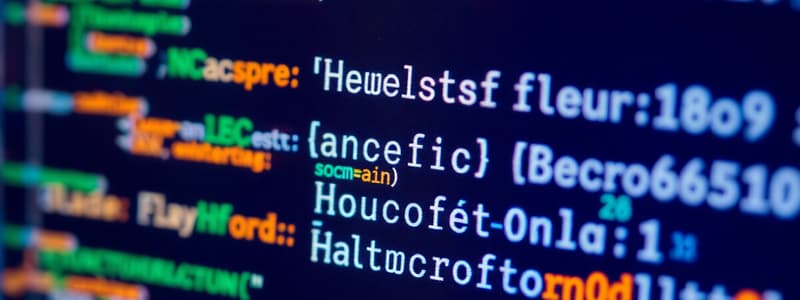Podcast
Questions and Answers
Which of the following best describes the primary focus of A-Level Computer Science Paper 2 (syllabus code 961)?
Which of the following best describes the primary focus of A-Level Computer Science Paper 2 (syllabus code 961)?
- Writing Python source code on a computer.
- Solving problems using pseudocode. (correct)
- Answering questions related to computer hardware.
- Creating graphical user interfaces.
The 'Diamond Book' is designed as supplementary reading material and does not include solutions to past paper questions.
The 'Diamond Book' is designed as supplementary reading material and does not include solutions to past paper questions.
False (B)
Name two high-level languages suggested by Cambridge for accessing the CPU.
Name two high-level languages suggested by Cambridge for accessing the CPU.
Python, Java, Visual Basic
Breaking down a complex problem into smaller, manageable parts is known as ______.
Breaking down a complex problem into smaller, manageable parts is known as ______.
Match the following descriptions with the correct computational thinking technique:
Match the following descriptions with the correct computational thinking technique:
Which of the following is a benefit of using decomposition in programming?
Which of the following is a benefit of using decomposition in programming?
In pattern recognition, the goal is to create unique code for each module, avoiding any reuse to prevent conflicts.
In pattern recognition, the goal is to create unique code for each module, avoiding any reuse to prevent conflicts.
Name two formats, besides pseudocode, in which algorithms can be written.
Name two formats, besides pseudocode, in which algorithms can be written.
The name of the book for learning Python coding is called The ______ Book.
The name of the book for learning Python coding is called The ______ Book.
What is the primary purpose of abstraction in computational thinking?
What is the primary purpose of abstraction in computational thinking?
Structured English uses formal programming syntax to describe programming logic.
Structured English uses formal programming syntax to describe programming logic.
Name one of the standard methods of solution commonly used in pseudocode for accumulating a sum.
Name one of the standard methods of solution commonly used in pseudocode for accumulating a sum.
Incrementing a counter in pseudocode, commonly using the expression Count = Count + 1, is known as ______.
Incrementing a counter in pseudocode, commonly using the expression Count = Count + 1, is known as ______.
Which search algorithm involves repeatedly dividing the search interval in half?
Which search algorithm involves repeatedly dividing the search interval in half?
Paper Four of the Computer Science A-Level focuses on theoretical concepts, with no practical coding component.
Paper Four of the Computer Science A-Level focuses on theoretical concepts, with no practical coding component.
What general programming skill is used on the written paper?
What general programming skill is used on the written paper?
Arranging data in a specific order, for example using the sorting algorithm ______ Sort, is a standard programming technique.
Arranging data in a specific order, for example using the sorting algorithm ______ Sort, is a standard programming technique.
What is the total duration allocated for the A-Level Paper 2 Computer Science exam?
What is the total duration allocated for the A-Level Paper 2 Computer Science exam?
Error handling is always effective for all modules and all errors in the entire program regardless.
Error handling is always effective for all modules and all errors in the entire program regardless.
What are the different ways in writing in Algorithm?
What are the different ways in writing in Algorithm?
Flashcards
Computational Thinking
Computational Thinking
Studying a problem and creating a computer-based solution.
Abstraction
Abstraction
Extracting essential details and ignoring irrelevant ones.
Decomposition
Decomposition
Breaking down a complex problem into smaller, manageable parts.
Pattern Recognition
Pattern Recognition
Signup and view all the flashcards
Algorithm
Algorithm
Signup and view all the flashcards
SuDoCo Code
SuDoCo Code
Signup and view all the flashcards
Totalling
Totalling
Signup and view all the flashcards
Counting
Counting
Signup and view all the flashcards
Finding the Largest Number
Finding the Largest Number
Signup and view all the flashcards
Linear Search
Linear Search
Signup and view all the flashcards
Binary Search
Binary Search
Signup and view all the flashcards
Sorting
Sorting
Signup and view all the flashcards
Structured English
Structured English
Signup and view all the flashcards
Study Notes
Overview of A-Level Paper 2 Computer Science
- The lecture is an introduction to A-Level Paper 2 for Computer Science (syllabus code 961).
- The exam duration is 2 hours, with a total of 75 marks.
- The paper is a written exam, similar to the O-Level Paper 2 format.
- While the exam focuses on pseudocode, students will also be taught Python for skill development and knowledge.
- A "Diamond Book" workbook has been created to aid in solving the paper, including lectures, solutions, and past paper practice.
- There are four chapters in the syllabus: Chapter 9, Chapter 10, Chapter 11, and Chapter 12. The goal is to cover Chapter 9 in the current class.
- A set of 13 books, including the Diamond Book, a planner, a revision book, and past papers for both Paper 1 and Paper 2, are available.
Introduction to Computational Thinking Skills
- Computational thinking is defined as the process of studying a problem and formulating an effective solution using computers.
- Involves using computer to study and solve problems
- Techniques include abstraction, decomposition, algorithms, and pattern recognition.
- Focus in algorithms includes structured English, flowcharts, and pseudocode.
Abstraction
- Abstraction involves extracting essential information while ignoring irrelevant details.
- The focus is on keeping key elements and discarding unnecessary information.
- Example: Filtering out irrelevant information from a client's description of their business to focus on the technical requirements.
Decomposition
- Decomposition involves breaking down a complex problem into smaller, manageable parts (modules).
- Modules make it easier to manage code.
- Allows for easier teamwork, as different teams can work on different modules.
- Reduces the impact of errors, as a problem in one module does not affect the entire program.
- An example includes Instagram and their story updates, each update is a "module" of code that then updates access to all the users.
Pattern Recognition
- Pattern recognition recognizes similar techniques or code blocks across different modules.
- Involves identifying similarities between modules and creating a reusable module for those common elements.
- Example: Identifying that two modules both use the same addition technique and creating a separate module for addition that both can call.
- Steps include identifying similar parts of a problem and creating reusable programming code, which is stored in a module (subroutine, function, or procedure).
Algorithms
- Algorithms involve writing tasks step by step in an ordered sequence.
- Algorithms can be written in multiple ways:
- Step by step
- Structured English
- Flow chart
- SuDoCo code
- The book for learning Python coding is called The Purple Book
Pseudocode
- When you switch on a computer, you need a high-level language in order to access the CPU
- Cambridge suggests three High-Level languages:
- Python
- Java
- Visual Basic
- A2 has a practical paper named Paper Four
- Paper four is on a high level language
- You need to write Python source code onto a computer
- A general programming skill known as "SuDoCo code" is used on the written paper
Standard Methods of Solution and Programming Techniques
- Several standard methods and techniques are commonly used in pseudocode:
- Totalling: Accumulating a sum (e.g.,
Total = Total + Number). - Counting: Incrementing a counter (e.g.,
Count = Count + 1). - Finding the Largest/Smallest Number: Iterating through a list to find the largest or smallest value.
- Linear Search: Searching each element in an array one by one.
- Binary Search: A search algorithm that involves splitting data into testing for larger or smaller
- Sorting: Arranging data in a specific order, with Bubble Sort being mentioned.
- Totalling: Accumulating a sum (e.g.,
- These techniques serve as standard solutions within programming.
Structured English
- Structured English involves writing programming logic in plain English for better understanding.
- It's a method of showing logical steps in clear, straightforward English.
- Can include numbering and keywords
- Example:
- Set total to zero
- Enter value for all numbers
- If N<output
Studying That Suits You
Use AI to generate personalized quizzes and flashcards to suit your learning preferences.




